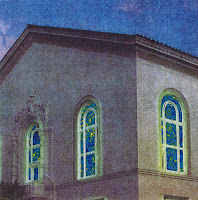 Conceptual artist Jonathon Keats has sent us a note with some more details about the "Atheon," his really cool new installation at the Judah L. Magnes Museum in Berkeley, California. As we reported earlier, the Atheon "calls forth the fusion of science and religion by building a temple for scientific worship," and it will appear in the 14-foot-high cathedral-style windows on the second floor of the museum's new downtown location while the inside of the building is being renovated.
Conceptual artist Jonathon Keats has sent us a note with some more details about the "Atheon," his really cool new installation at the Judah L. Magnes Museum in Berkeley, California. As we reported earlier, the Atheon "calls forth the fusion of science and religion by building a temple for scientific worship," and it will appear in the 14-foot-high cathedral-style windows on the second floor of the museum's new downtown location while the inside of the building is being renovated.
Keats is now sharing the details of his plan. "The essence of religion is stained glass and song," he says, and the stained glass of the Atheon will be patterned to show the cosmic microwave background radiation—afterglow light from the big bang–which has been mapped and measured by NASA's Wilkinson Microwave Anisotropy Probe. "The cosmic microwave background is the sky's natural stained glass, our origin story imprinted on the cosmos," says Keats. "And now it's visible to us for the first time, glowing through the windows of the Atheon."
The accompanying song will be a "canon for three cosmic voices" called "Why Is There Something Rather Than Nothing?" Keats musically arranged the song using audio files of sounds "pulsating through several hypothetical universes as well as our own living cosmos" that were produced by University of Virginia astronomer Mark Whittle.
"When you listen to people like Nobel laureate cosmologist Steven Weinberg, or Oxford biologist Richard Dawkins, you hear a lot of talk about how god-based religion is out-of-date," says Keats. "The leading minds believe that science can and should provide a spiritually satisfying replacement. But until recently no one bothered to consider what form that alternative might take." Keats says he's "hardly the best person for the job, but if I didn’t take it on, nobody would."
For now, because of the construction work inside the museum, the Atheon will be visible only from the sidewalk, with the windows illuminated every night until February 1. Those who can't make it to the museum will be able to hear the canon and see the glow of the radiation on the Atheon's Web site, meaning they can "turn off their lights and set up a miniature shrine to science on their home computer." The site (www.magnes.org/atheon) is scheduled to go live later this month.
"Eventually there will be an Atheon in every town," says Keats. "There will be many different architectures and diverse liturgies. Science will make a fine religion. What remains to be determined is whether this religion will be good science." —Heather Wax
Monday, September 8, 2008
More on the "Atheon": A Temple to Science
Posted by Heather Wax at 10:03 AM
Subscribe to:
Post Comments (Atom)



2 comments:
“Atheon.” What will they think of next? I love the idea and I can imagine a lot of people will. But a “temple to science?” Won’t that enrage PZ Myers and his minions who are certain that there are no religious aspects to science?
The great tragedy of our time is not that we have no Atheons. The tragedy is that we almost never celebrate science inside our conventional houses of worship. So great is the divide between science and religion that many Americans would think it sacrilegious to celebrate science with beautiful art inside our churches. Atheons will only make this divide wider. The tiny minority of people who exercise their religious impulse inside an Atheon will convince the vast majority with conventional religious beliefs that there is something fundamentally atheistic about science. The last thing we need is another argument supporting claims that science is atheistic. Those arguments lead to meddling with evolution in the public schools, where it is already on the run.
I doubt the Atheon will function as a true temple. Keats conviction that "The essence of religion is stained glass and song,” is off the mark in mistaking the form for the content. The heart of religion is its transforming power—a power that leads people to sing and create art. If Atheons are truly religious we will know soon enough for they will have homeless shelters in their basements and the “parishioners” will start feeding programs for the hungry.
Keats is very very confused. Religion is ultimately about faith. Science is ultimately about that which can be proved through experiment. Thus science and relgion are separate human endeavors. Science is not a relgion. The concept of a temple of/to science is not merely silly, it shows a fundamental misunderstanding as to the nature of scientific inquiry.
The reason religion and science come into conflict is because there are religious people who apparently need to feel that relgion and science are the same thing; that both science and religion solving the same problem (e.g. explainingg why the world is the way the world is). These people seem to understand neither science nor relgiion. Rather in their fundamentalism they choose to believe in "truths" because someone tells them to believe it, and they take any questioning of such "truths" as attacks on their religion.
Post a Comment